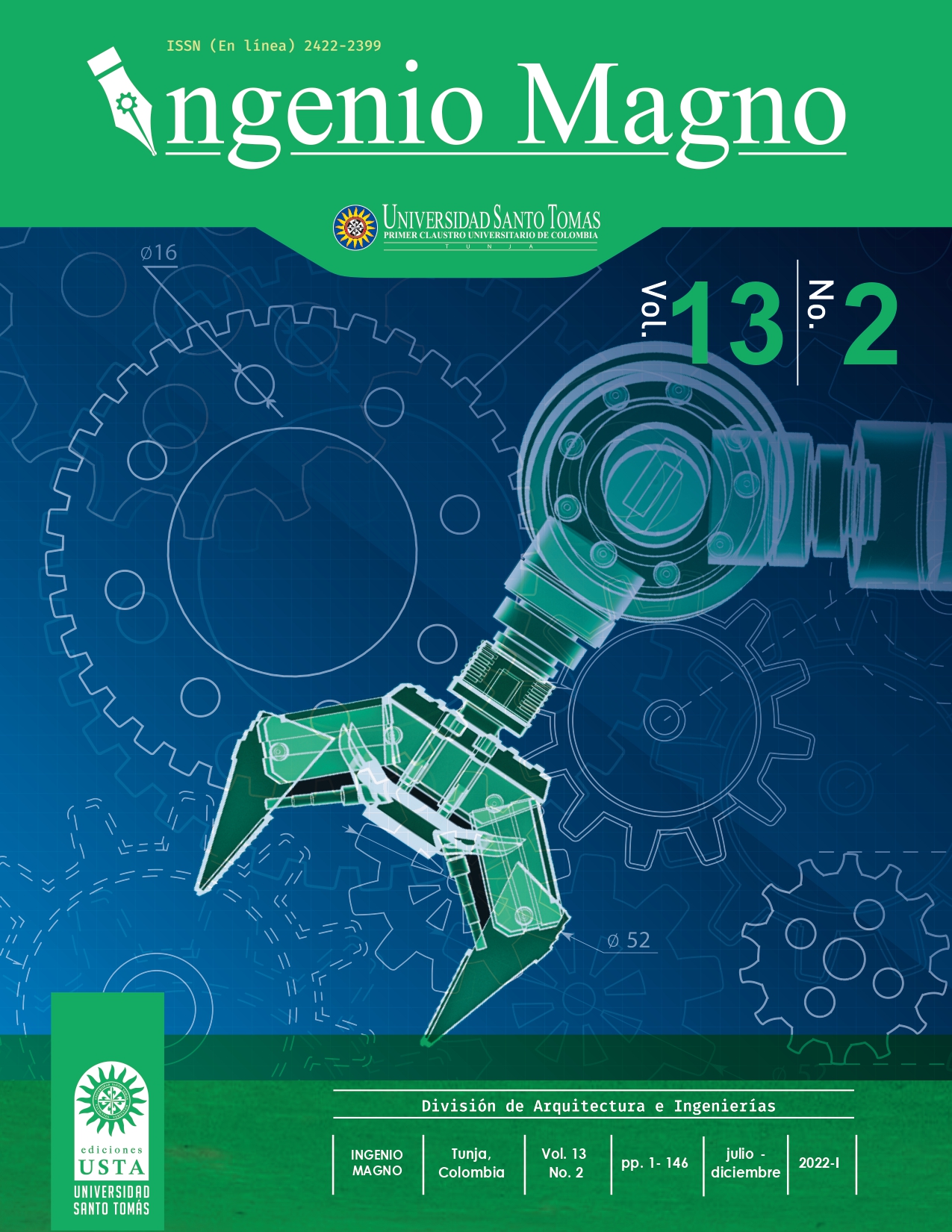Una revisión del autoensamblaje enfocado en escala macroscópica
Contenido principal del artículo
Resumen
Descargas
Detalles del artículo
DECLARACIÓN DE ORIGINALIDAD DE ARTÍCULO PRESENTADO
Por medio del presente documento, certifico(amos) que el artículo que se presenta para posible publicación en la revista institucional INGENIO MAGNO del Centro de Investigaciones de Ingeniería Alberto Magno CIIAM de la Universidad Santo Tomás, seccional Tunja, es de mi (nuestra) entera autoría, siendo su contenido producto de mi (nuestra) directa contribución intelectual y aporte al conocimiento.
Todos los datos y referencias a publicaciones hechas están debidamente identificados con su respectiva nota bibliográfica y en las citas que se destacan como tal. De requerir alguna clase de ajuste o corrección, comunicaré(emos) de tal procedimiento con antelación a los responsables de la revista.
Por lo anteriormente expresado, declaro(amos) que el material presentado en su totalidad se encuentra conforme a la legislación aplicable en materia de propiedad intelectual e industrial de ser el caso, y por lo tanto, me(nos) hago (hacemos) absolutamente responsable(s) de cualquier reclamación relacionada a esta.
En caso que el artículo presentado sea publicado, manifiesto(amos) que cedo(emos) plenamente a la Universidad Santo Tomás, seccional Tunja, los derechos de reproducción del mismo.
Citas
Bhalla, N., & Bentley, P. J. (2012). Programming Self-Assembling Systems via Physically Encoded Information BT - Morphogenetic Engineering: Toward Programmable Complex Systems (R. Doursat, H. Sayama, & O. Michel (eds.)). Springer Berlin Heidelberg. https://doi.org/10.1007/978-3-642-33902-8_7
Bhalla, N., Bentley, P. J., Vize, P. D., & Jacob, C. (2014). Staging the Self-Assembly Process: Inspiration from Biological Development. Artificial Life, 20(1), 29–53. https://doi.org/10.1162/ARTL_a_00095
Bhalla, N., Ipparthi, D., Klemp, E., & Dorigo, M. (2014). A Geometrical Approach to the Incompatible Substructure Problem in Parallel Self-Assembly BT - Parallel Problem Solving from Nature – PPSN XIII (T. Bartz-Beielstein, J. Branke, B. Filipič, & J. Smith (eds.); pp. 751–760). Springer International Publishing.
Grünwald, M., Tricard, S., Whitesides, G. M., & Geissler, P. L. (2016). Exploiting non-equilibrium phase separation for self-assembly. Soft Matter, 12(5), 1517–1524. https://doi.org/10.1039/C5SM01922B
Hacohen, A., Hanniel, I., Nikulshin, Y., Wolfus, S., Abu-Horowitz, A., & Bachelet, I. (2015). Meshing complex macro-scale objects into self-assembling bricks. Scientific Reports, 5(1), 12257. https://doi.org/10.1038/srep12257
Hafez, A., Liu, Q., & Santamarina, J. C. (2021). Self-assembly of millimeter-scale magnetic particles in suspension. Soft Matter, 17(29), 6935–6941. https://doi.org/10.1039/D1SM00588J
Hageman, T., Löthman, P., Dirnberger, M., Elwenspoek, M., Manz, A., & Abelmann, L. (2018). Macroscopic equivalence for microscopic motion in a turbulence driven three-dimensional self-assembly reactor. Journal of Applied Physics, 123, 24901. https://doi.org/10.1063/1.5007029
Haghighat, B., Mastrangeli, M., Mermoud, G., Schill, F., & Martinoli, A. (2016). Fluid-Mediated Stochastic Self-Assembly at Centimetric and Sub-Millimetric Scales: Design, Modeling, and Control. In Micromachines (Vol. 7, Issue 8). https://doi.org/10.3390/mi7080138
Ipparthi, D., Winslow, A., Sitti, M., Dorigo, M., & Mastrangeli, M. (2017). Yield prediction in parallel homogeneous assembly. Soft Matter, 13(41), 7595–7608. https://doi.org/10.1039/C7SM01189J
Jílek, M, Somr, M., Kulich, M., Zeman, J., & Přeučil, L. (2021). Towards a Passive Self-Assembling Macroscale Multi-Robot System. IEEE Robotics and Automation Letters, 6(4), 7293–7300. https://doi.org/10.1109/LRA.2021.3096748
Jílek, M, Stránská, K., Somr, M., Kulich, M., Zeman, J., & Přeučil, L. (2022). Self-Stabilizing Self-Assembly. IEEE Robotics and Automation Letters, 7(4), 9763–9769. https://doi.org/10.1109/LRA.2022.3191795
Jílek, Martin, Kulich, M., & Preucil, L. (2020). Centimeter-scaled Self-Assembly: A Preliminary Study. https://doi.org/10.5220/0009830104380445
Kimura, K., Okuyama, T., Okano, T., & Suzuki, H. (2018). Selective bonding method for self-assembly of heterogeneous components using patterned surfaces. Sensors and Actuators A: Physical, 279, 306–312. https://doi.org/https://doi.org/10.1016/j.sna.2018.06.001
Liu, Y., Chen, Y., Jiang, X., Ni, Q., Liu, C., Shang, F., Xia, Q., & Zhang, S. (2022). Self-Assembly at a Macroscale Using Aerodynamics. In Applied Sciences (Vol. 12, Issue 15). https://doi.org/10.3390/app12157676
Löthman, P. A., Hageman, T. A. G., Elwenspoek, M. C., Krijnen, G. J. M., Mastrangeli, M., Manz, A., & Abelmann, L. (2020). A Thermodynamic Description of Turbulence as a Source of Stochastic Kinetic Energy for 3D Self-Assembly. Advanced Materials Interfaces, 7(5), 1900963. https://doi.org/https://doi.org/10.1002/admi.201900963
Masumori, A., & Tanaka, H. (2013). Morphological computation on two dimensional self-Assembly system. https://doi.org/10.1145/2503385.2503412
Metzmacher, J., Poty, M., Lumay, G., & Vandewalle, N. (2017). Self-assembly of smart mesoscopic objects. The European Physical Journal E, 40(12), 108. https://doi.org/10.1140/epje/i2017-11599-y
Mitsui, M., Masumori, A., Asakura, R., & Tanaka, H. (2014). Applying Self-Assembly and Self-Reconfigurable Systems for Printer. https://doi.org/10.7551/978-0-262-32621-6-ch086
Nakajima, K., Ngouabeu, A. M. T., Miyashita, S., Göldi, M., Füchslin, R. M., & Pfeifer, R. (2012). Morphology-Induced Collective Behaviors: Dynamic Pattern Formation in Water-Floating Elements. PLOS ONE, 7(6), e37805. https://doi.org/10.1371/journal.pone.0037805
Niu, R., Du, C. X., Esposito, E., Ng, J., Brenner, M. P., McEuen, P. L., & Cohen, I. (2019). Magnetic handshake materials as a scale-invariant platform for programmed self-assembly. Proceedings of the National Academy of Sciences, 116(49), 24402–24407. https://doi.org/10.1073/pnas.1910332116
O’Hara, I., Paulos, J., Davey, J., Eckenstein, N., Doshi, N., Tosun, T., Greco, J., Seo, J., Turpin, M., Kumar, V., & Yim, M. (2014). Self-assembly of a swarm of autonomous boats into floating structures. 2014 IEEE International Conference on Robotics and Automation (ICRA), 1234–1240. https://doi.org/10.1109/ICRA.2014.6907011
Okuyama, T., Hikida, T., Okano, T., & Suzuki, H. (2020). Selective self-assembly of three-component system based on hydrophilic/hydrophobic patterning. Sensors and Actuators A: Physical, 312, 112143. https://doi.org/https://doi.org/10.1016/j.sna.2020.112143
Papadopoulou, A., Laucks, J., & Tibbits, S. (2017). From Self-Assembly to Evolutionary Structures. Architectural

